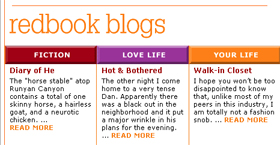
Hearst Corporation has a long and storied history as a media conglomerate, starting from the days of old-school media baron William Randolph Hearst and his twin inventions of the penny press and sensational journalism, all the way through its current form as a diversified private media company.
In the online arena, it has been more successful as an investor in Internet startups through Hearst Interactive Media (investments include iVillage, Brightcove, Sling Media, and XM Satellite Radio) than through websites related to its own magazines, newspapers or broadcast outlets. For a long time, Hearst’s magazine sites were outsourced completely through iVillage.
But once iVillage was sold to NBC Universal in May 2006, Hearst decided to invest more heavily in its Internet presence, and created a new division, Hearst Magazines Digital Media, dedicated to in-house website production and integration. While this was a late date to start running magazine adjunct websites, long a staple at other publishers, Hearst had the advantage of creating an Internet startup mentality within a big corporation, with little of the legacy systems of a Web 1.0 operation. In the past year, the division has hired more than 100 people (half of whom are in technical or production jobs), and has launched revamped sites for magazines such as Cosmopolitan, Redbook and Seventeen.
According to Chuck Cordray, vice president and general manager of the new division, his group launched 14 new websites and five mobile sites from just last February to May. He said that Hearst’s strategy is to super-charge its sites to help drive younger readers into print subscriptions, while also using print to drive readers online and to the company’s mobile initiatives. Cordray says the company is not overly concerned about its websites cannibalizing or substituting for print products.

“The likelihood of an individual online visitor to subscribe [to a print magazine] has gone up more than 50 percent,” he said. “We have had sites that have doubled their propensity for an individual visitor to subscribe. This isn’t about cannibalization, it’s about brand experience. If you have a good experience in print, you might try out the mobile experience. If you have a good experience online, you might subscribe to the print publication. This is about brand reinforcement, not about cannibalization.”
While the Hearst online unit has relaunched all of the company’s magazine sites, it has also been busy with acquisitions, buying out teen network eCrush in January, and nabbing men’s online network UGO and social shopping site Kaboodle in the past few weeks. Plus, Hearst has launched online-only destinations such as environmental site The Daily Green and MyPromShopper.com. The eCrush sites had about 1.6 million unique visitors in July, while Seventeen.com had about 1 million and Cosmopolitan.com had 824,000 uniques, according to comScore.
I recently had an extensive conference call with Cordray. The following is an edited transcript from that call, covering the launch of the new division, Cordray’s desire to buy a food site, and his thoughts on the future of print magazines.
Paint for me the ‘before’ and ‘after’ picture there. How were things run before Hearst Magazines Digital Media came into existence and how are they run now?
Chuck Cordray: Essentially, there was no ‘before.’ Before, everything was outsourced. In March of 2006, our division was founded and at that point we had a small group of people handling print subscription sales. We had less than a dozen online editors for the [magazine] titles. They were literally emailing Word documents to iVillage, they had no content management system at all. Everything else was done out of house.
Since then, we built our content management system on an open source platform.. We built a circulation management system to sell those [print] subscriptions that are so profitable for the company. In October 2006, we took live our major system for subscriptions, by December we took the content management system live, and by February 2007 we launched the first set of sites. Between February and May, we launched 14 sites and five mobile sites. It’s been a busy time, a little crazy.
Before there weren’t even servers here to put content on. I joked in the first three months at Hearst Magazines Digital Media, ‘we don’t really have digital media yet, but we’ll get there.’ Our philosophy was that for things that are critical, we must control them. The things we believe are critical are the content management system — we couldn’t find one on the outside, so we built our own. For circulation, there are only four or five publishers with the scale to justify the resources. We wanted to update the [circulation] tools and have them fully integrated into our content management system, so that marketing knows the context of the page and the subscriber.
Why is this kind of circulation system important?
Cordray: Before there were hard-coded [print subscription] offer pages [online], and we had somewhere between eight and a dozen offers per title, depending where you were coming into the site from. We had some customization of that offer that may reference a special promotion with a partner or a Mother’s Day special. It was eight to 12 offers, and now we’re running at 150 offers per title. Some of it is creative rotation. As you went page to page on iVillage, the creative to sell subscriptions was the same no matter how deeply into the site you went. Now it changes page to page.
Today we can literally have 100 versions of a different offer, and parse the traffic out and see which ones are working best, and then change it. We can say, ‘This one is best’ and take out the other versions. That has given us enormous flexibility in how we market our subscriptions.
Can you talk at all about numbers for revenues or profitability for the division?
Cordray: As a private company, we have the luxury of not commenting, and it’s generally our policy not to. We are well ahead of every goal we had for traffic and for subscriptions. We don’t really comment on the magnitude of where the numbers are.
[Note: Forbes magazine estimates Hearst Corp. had $4.4 billion in revenues in 2005, up 12.6% over the previous year, ranking it #46 among private companies in America.]
How does digital fit in revenue-wise within Hearst? Is it something people see as becoming a bigger revenue driver, maybe even more than magazines at some point?
Cordray: We don’t really make comparisons of one media vs. the other. There are different [ad] budgets [at companies] and we go after them. Our digital sales team targets digital agencies. Our print teams target print agencies and print budgets. Our philosophy is that what we have built are great online expressions of trusted brands. We don’t view them as competitive but as complementary. Our consumers and advertisers are online and in print. We want to find the consumer who wants to find the information and entertainment we provide. Online or on a mobile device, the cannibalization argument — ‘won’t putting our brands online hurt our print products?’ — the sites are so much more robust as they were on iVillage. They are so much deeper.
If anything, the substitution risk would go up now that we have really good, really deep sites. The reality is not just in total number, but the likelihood of an individual online visitor to subscribe [to a print magazine] has gone up more than 50%. We have had sites that have doubled their propensity for an individual visitor to subscribe. This isn’t about cannibalization, it’s about brand experience. If you have a good experience in print, you might try out the mobile experience. If you have a good experience online, you might subscribe to the print publication. This is about brand reinforcement, not about cannibalization. That’s exactly not the point. Good brands are about who provides good content, who do they trust. This is an opportunity to have our brands everywhere.
You talked about having print and digital sales teams. What’s your philosophy on keeping online and print either separate or integrating them?
Cordray: Our philosophy is that we have to match what advertisers want. Today we are a matrix, but it will evolve. God knows how it will evolve, but it will evolve. The way the matrix works is that on the editorial side, we have a central team of online editors who work across the network. The head of online content and all online editors report jointly to someone within the print editorial team — sometimes that’s the editor in chief and sometimes the managing editor. And they also report into digital. [Online editors] sit on the magazine’s editorial floor.
On the magazines, we handle it with joint reporting. On the sales side, we sell as a network and we also sell individual brands. When we’re going out to a digital agency, the digital team represents all of Hearst digital so that they can say to a beauty advertiser, here’s Cosmopolitan, Marie Claire, Seventeen, CosmoGirl — here’s the gamut for the appropriate target for you. We sell by demographic or category and sell across the network.
But if the Cosmopolitan person is going in to see a [print] account, they also have digital programs that can be combined with print. At a certain size or complexity, like if it includes rich media, then the print person must bring along someone from digital. If it involves a budget of more than X, the digital person must go along. But the print person can offer podcasts and mobile and inventory from the site he or she is representing. If there’s more than one site, then digital has to be involved.
If an online editor reports to both digital and print bosses, where does that eventually lead? Is there a print person at the top?
Cordray: The print editors all report to Cathie Black, the president of the Hearst [Magazines] group. That’s the end of that line. On online, content reports up to me. My boss reports to Cathie Black. Everything eventually reports up to Cathie Black.

There’s a lot of talk about the Long Tail online, all the micro-content and blogs and niches. You have sites like The Daily Green that covers a niche. How important is it to band them together vs. having them keep a unique identity?
Cordray: At the moment, 80% of our online sales are network sales [going across more than one site]. Clearly the power of the network allows us to offer more scale. The remainder comes mainly from print salespeople taking out digital programs from across those brands. Over time, as the individual brands get a bigger audience, people will want to target particular sites, and we do get that today. Forget print, but an online advertiser who just wants one site is quite rare for us. Generally they come in and say, ‘I want teens, and all teens are good.’ Or ‘I want 18 to 34, and three or four of your brands deliver that, so I’ll take the brands that deliver across the demographic target.’
Editorially, how much do you share resources vs. keeping them separate?
Cordray: Those resources are essentially separate. There are certain things we share and cross-promote, but they are separate businesses and we run them separately. For online content, 50% to 80% of it is original content to online. It may be on the same theme as the magazine article. Redbook may offer an article on stress reduction that becomes the basis for an online package that may feature interactive quizzes on ‘How Stressed Are You?’ and top 10 lists on how to become less stressed. There’s a similarity but appropriateness for the medium, and that means that sharing resources is hard to do on the content side because so much of it is brand-specific.
So walk me through the editorial process for a story in Redbook, for instance. Is online brought into the equation from the beginning of an article or later?

Cordray: It varies from title to title, but let’s say with Redbook, it’s a great example of how well the integration can work. There are columnists who also blog. Most of the Redbook staff has written something for the website. In the early planning stage, when a print issue is being planned, the potential online applications for that issue are planned immediately. ‘What can we do, what can we promote in-book to tell people to get more?’ Here are 10 recipes, go online to get more. Those are things that begin when the issue is planned.
Separately, online is planning for original content for the web that has nothing to do with the [print] issue but does resonate with the brand. Online is the major way that submissions of content come into our teen magazines. They are unlikely to write a long-hand letter today. All of our sites have submission forms. There’s some variant of “Talk to Us” that lives on all the sites. They can submit stories online, and they are not published like a comment is. They are literally writing a story. In CosmoGirl, it might be, ‘Tell us about your first kiss.’ Or in Seventeen, ‘what was your most challenging beauty nightmare and how did you solve it?’ That submission happens online even though it will see its first airing in print. It’s more integrated all the time.
Do you see a day when there is no online or print staff, but just one staff doing both?
Cordray: My personal belief is that if that day exists it will be a very long time from now. I don’t believe it will ever happen. It’s hard enough training people to learn ‘ what is it that this brand represents?’ To have a large staff who knows what the brand means and represent it in multiple media, it’s very hard. Maybe this is an area in which I am a Luddite, but I feel like it will be a very long time before that happens.
Hearst has done a lot of investing and buying in the digital realm. Recently you bought UGO and Kaboodle, and you’ve also launched stand-alone sites like Daily Green. How do you decide whether to buy or build a site?
Cordray: I think it comes down to this: ‘Is it a core competency for us? Is it a need for our audiences?’ I’ll use the Kaboodle example. [Social shopping site] Kaboodle has great technology, and they know what they’re doing. If we set out to do what they’re doing today, it would take us a year to 18 months — if we could do it — and by the time that’s over, we’d be so far behind them, why are we bothering to do it?
On other things like food, I would love at some point to do a food acquisition to add to our portfolio but we are also building out our food resources. We have what we call internally “Recipe Finder 1” and in September we’ll release a greatly advanced version of that. We’ll continue to advance our food tools but we’d also like to add scale from the outside. In some cases, you’ll see us do both, buy and build. One site’s not going to win everything.
How would you describe your demographic for Hearst properties offline and online?
Cordray: It’s so different from brand to brand that I’m hesitant to characterize it that way. But one thing I can say is that the print subscribers who subscribe online are generally eight to 10 years younger on average than the ones who subscribe through the traditional methods. The online people are finding us sooner. And of the online subscribers, more than 90% of them are brand new to the Hearst subscription world — they’ve never subscribed to any of our magazines before. They look the same as our other subscribers but we’re getting them earlier.
Hearst has an investment in E Ink and I’m curious how you see things changing with reading habits in the future. Do you think people will rely less on print magazines and go online more and use e-readers?
Cordray: I’m going to punt on that question because E Ink is part of the investment arm, Hearst Interactive Media, as opposed to Hearst Magazines Digital Media, which is what I run. As a magazine reader, my own personal opinion is that magazines will be around for my whole lifetime and everyone else’s. I think some formats are more challenged than others, but as a mechanism for discovery and edited choice and beautiful photography, magazines are a pretty incredible experience. There are some interactive experiences that are better online.
Most of our magazines are older than radio, older than television and cable. With each media upheaval, magazines have evolved and come out better on the other side. They evolve, but all brands evolve.
*****
What do you think about Hearst’s revamped websites for its magazines and the sites it has bought? Has the in-house approach worked better than going through iVillage, or do you think there’s something they could do better? Share your thoughts in the comments below.

These sites, for the most part, are all very LCD. What I see are sweepstakes and giveaways, lots of shovelware, and very little multimedia. Even upscale titles like ESQUIRE has a site that does little more than throw magazine articles online. Also, the production values are nothing to write home about.
These sites, for the most part, are all very LCD. What I see are sweepstakes and giveaways, lots of shovelware, and very little multimedia. Even upscale titles like ESQUIRE has a site that does little more than throw magazine articles online. Also, the production values are nothing to write home about.